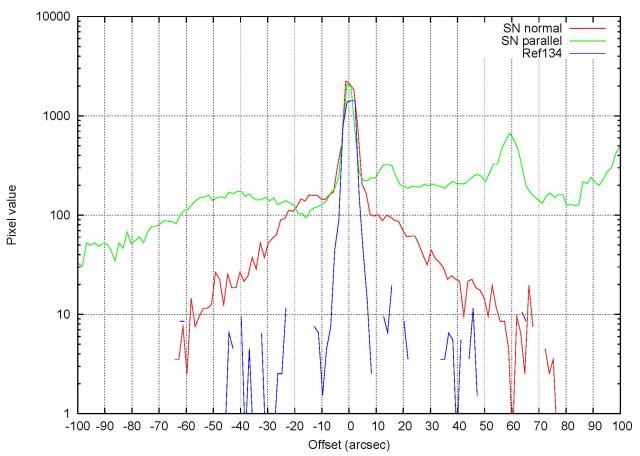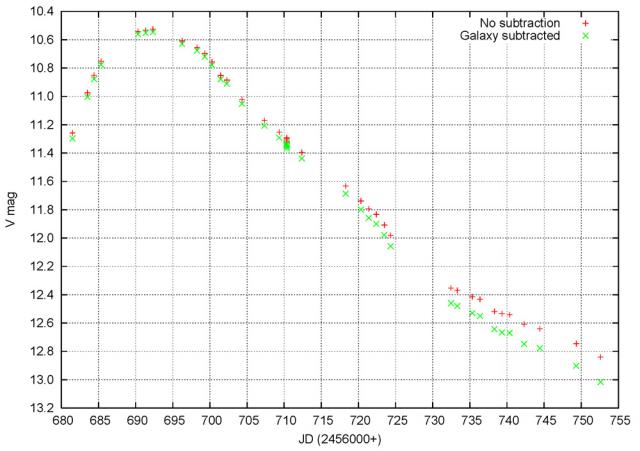› Forums › Variable Stars › Removing M82 from SN 2014J
- This topic has 5 replies, 3 voices, and was last updated 11 years, 8 months ago by
 Gary Poyner.
Gary Poyner.
-
AuthorPosts
-
6 April 2014 at 9:04 am #573334
 Nick JamesParticipant
Nick JamesParticipantSince SN 2014J has now faded to around mag 13 in V the background galaxy is starting to have a significant effect on photometry. I’ve been doing some experiments using some IRAF scripts to remove the galaxy from a V-band image obtained yesterday morning (2014 April 5) and have measured the frames in each case. Using the AAVSO sequence I get V=12.839 if I don’t remove the galaxy and V=13.021 if I do. This is a significant difference. My check star is the same in both cases (V=12.296 vs V=12.292).
Does anyone else have any experience of doing this? If so, what tools do you use and what kind of results do you get? I assume that this also affects visual observers but they must somehow compensate for the galaxy background. Do the AAVSO/BAA have any recommendations as to what to do in these cases?
Nick.

Raw image showing the AAVSO comparison stars, check star and SN

Processed image after galaxy removal

Comparison of photometry fits (top before removal, bottom afterwards)
6 April 2014 at 12:10 pm #576511 Gary PoynerParticipant
Gary PoynerParticipantHello Nick,
Speaking personally and with my visual hat on, there is no way a visual observer can compensate for the background galaxy. I’m sure there lies somewhere an obscure equation to allow for this, but I don’t know of it. I have always been sceptical about applying corrections to visual observations – even for red bias in personal equations – as there are just too many factors to take into consideration. Far better to leave well alone.
I can see some unusual behaviour in the light curve in mv compared to V as the SN has faded, and unusually the fading trend is slightly different too, which I find very interesting. In most cases the trend remains similar whilst there are differences in measured values.
Your experiments in removing the galaxy from the image are fascinating, but it doesn’t surprise me that your V measure changes. I hope you’ll keep us informed as to whether you can improve the difference between the two measures. In the meantime I would urge visual observers who are observing this SN (and lets hope that as it fades visual observers keep at it) not to worry about the galaxy at all, and put all their efforts in to obtaining the best visual measure they can get.
Gary
6 April 2014 at 6:58 pm #576512 Jeremy ShearsParticipant
Jeremy ShearsParticipantNick,
there is a thread on this topic here: http://www.aavso.org/aperture-photometry-strategy-sn-2013
Go well!
Jeremy
6 April 2014 at 11:06 pm #576513 Nick JamesParticipant
Nick JamesParticipantJeremy,
The AAVSO thread is correct that the main problem here is the lumpy background of the galaxy. A uniform background would be fine since you could estimate it in the same way you do the sky and then subtract it from the measured counts. A lumpy background is much more difficult to handle and while using a small photometric aperture helps to a certain extent there is only so small you can go. As the thread says, the only real solution is to find a way to subtract the galaxy. I’ve been doing this using some IRAF routines to synthesise an SN-free galaxy but these are not particularly user friendly and IRAF is Unix/Linux based and so not widely available to amateurs. I wonder if people have any ideas for Windows based ways of doing this? This is becoming significant now as the SN fades.
The graph below shows the problem. It shows cuts through the SN (about 13.0V) normal and parallel to M82’s plane and a cut through one of the comp stars (13.4V). The pixel values are sky subtracted. The comp star is well away from the galaxy but the SN is in it and lies on a very lumpy background that will distort the counts.

Pixel value counts through the SN and one of the comp stars (134) obtained on 2014 April 5.
7 April 2014 at 7:03 pm #576514 Nick JamesParticipant
Nick JamesParticipantI’m not sure it’s right for me to comment on my own comments but here’s my V band lightcurve with and without the galaxy subtracted. It is clear that the subtraction makes a significant difference now and this will only become more important as the SN fades.
 8 April 2014 at 10:50 am #576516
8 April 2014 at 10:50 am #576516 Gary PoynerParticipant
Gary PoynerParticipantJust a simple observation – the subtracted values bring the light curve closer to visual magnitude – so it must be working! 😉
Gary
-
AuthorPosts
- You must be logged in to reply to this topic.
